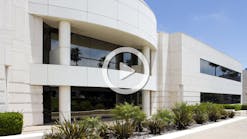Supplying a major beef-packing producer with landfill gas (LFG) for steam production is allowing the Seward County Landfill in Liberal, KS, to provide the company with estimated six-figure annual savings in electricity costs. Supplying boilers with fuel (i.e., direct use) is one major application for MSW managers; others include electrical genset power and alternative fuel production such as ethanol and liquefied natural gas (LNG).
The examples of successful LFG use below are all award-winning projects in the EPA’s Landfill Methane Outreach Program (LMOP), a voluntary assistance program that helps to reduce methane emissions from landfills by encouraging the recovery and beneficial use of LFG as an energy resource.
In Seward County, National Beef Packing Co. LLC—which already had been utilizing methane from its own 25-acre plot of open-air lagoons for boiler steam production for a couple of years—approached the county about adding to the methane supply with LFG from the landfill. Since 2008, the county has piped LFG to the wastewater lagoons, where it and the lagoon methane are collected and recovered to National Beef’s boilers. The steam is used to heat water for the company’s food safety intervention systems as well as for cleaning the facility. In addition the steam is used in rendering areas in processes such as cooking product and melting tallow.
When National Beef approached the county about using its LFG, the landfill had a closed, 10-acre, lined, Subtitle D cell with passive gas vents and another open, unlined, 28-acre cell with no gas collection but a leachate cleanout, according to Mike Tabor, director of the Seward County Landfill and waste management services. National Beef had a small gas-diversion system consisting of two 25-horsepower blowers installed and covered the lagoons with a floating high-density polyethylene (HDPE) cover. At a rate of 70 standard cubic feet per minute (scfm), LFG travels 1,500 feet from the landfill to a lagoon, where the piping penetrates the HDPE cover system, which traps the gas and feeds it underwater through a 300-foot perforated pipe.
Tabor acknowledges that the project is not particularly large in volume. The landfill takes in about 225 tons per day and had 1.5 million tons of waste in place as of 2007. “We hadn’t done a feasibility study, and we just didn’t think that we had enough gas for anybody to be interested in it—we just didn’t think it was feasible,” he says. “When National Beef came to us and said they wanted to explore it, we did a feasibility study on what we thought we could generate. It was enough, and they were interested in purchasing the gas from us and putting in a system.
LFG from the Enoree Landfill Phase II project in Greenville, SC, powers this electricity generation facility.
“The beauty of this thing was that when we set up this system, National Beef was looking for any source for alternative energy. Even with the amount we give to them, they were able to recover their cost off of it in the first year and a half. Once they got to that point, they started paying us for the gas. Even as remotely located as we are in southwest Kansas, having a beef-packing plant literally within 100 yards of your facility makes a big difference.”
The landfill contributes 10% to 15% of the alternative fuel source to the beef-packing operation’s steam production, Tabor estimates. The county’s revenue stream is not huge—perhaps $15,000 to $30,000, he estimates—but it is a revenue stream that did not exist previously. “It was gas that was being vented to the atmosphere, and now it’s not, so we’ve turned it into a revenue stream for the county.” Other benefits include offsetting disposal costs for 55,000 customers in the region and some control of odor at the beef-packing facility and the landfill. The project earned Seward County LMOP’s 2008 Community Partner of the Year award.
“They’re a big customer of ours on the solid waste side, and we’re good neighbors with them,” Tabor notes. “This was a great partnership between government and a private entity to put something together like this. What amazes me about it most is that it’s a very, very small system—you see multimillion-dollar systems going in larger landfills. We did this little system and all of a sudden we got all of this interest in it. The EPA even came all the way out here to look at this system.
“But what it shows everybody is that there’s a use even for the small systems. Not every landfill is located next door to a source for landfill gas, and I know of some other landfills that are interested in this but they’re out in the middle of nowhere, so they have to use it themselves somehow or put in a huge amount of capital to pipe it somewhere. We looked at microturbines to use our own gas, but the capital investment was four or five times what this other system was and then the payback on it would have been 10, 15 years. That wasn’t nearly as feasible as this system was.”
Alternative Fuel for Alternative Fuel
Another project makes use of LFG to produce boiler steam used in ethanol production. Starting in 2009, the 10.2 million–ton Sioux Falls [SD] Regional Sanitary Landfill began providing LFG to a boiler alongside a wood waste-fueled boiler at a 105 million–gallon plant operated by Sioux Falls–based Poet LLC, the world’s largest ethanol producer. The LFG displaces about 10% of the plant’s natural-gas consumption and is expected to increase to 30% by 2025.
The city of Sioux Falls figured that using the LFG as an alternative fuel source, rather than flaring it, had to be feasible. In a 2006 LFG-use feasibility study, ethanol was the clear winner over generation of electricity, explains Dave McElroy, landfill superintendent for the city. “In South Dakota, we don’t have high electricity costs—most of our power comes from the Missouri River dam system, and that’s a really cheap source of electricity,” McElroy explains. “We would have gotten maybe 5 cents per kilowatt-hour. Our pro formas that were part of the landfill gas feasibility study showed that there were years where we’d maybe even lose money or generate up to maybe $200,000 in net revenue, whereas with ethanol generation we’d make $800,000 to almost $2 million when we were running at peak. It was a lot more financially attractive.”
Once it was decided that the LFG would be captured and diverted to the facility, the city wanted to get its LFG supply infrastructure set up before the winter of 2008–2009. Poet had modified its boiler to handle methane from the landfill and received a permit, which helped the process, McElroy says. Getting it up and running would reduce the payback period, he adds. “It really ended working out really well because people in the landfill realm know what a hit we took with the economy,” he points out. “Our revenues went down significantly because the waste tonnages went down. We were really glad we started the landfill gas project and got that additional revenue source going sooner rather than later. We didn’t know at the time when we put it on a rush fast track process, but it ended up working really well.”
The city let four separate contracts to get the 1,250-scfm operation up and running. Unison Solutions LLC of Dubuque, IA, provided an LFG conditioning skid that dehydrates and compresses the gas. Husman Construction Co. of Sioux Falls constructed the building to house the conditioning skid. Performance Pipe supplied the piping system, and Ellingson Companies of West Concord, MN, used a fast-fusion welder to install 11 miles of pipeline in just two months. R.W. Beck provided consulting design services from its Minneapolis office.
With winter looming, the compressor building was completed before installation of the drying and compression system. The treatment skid had to be placed inside the constructed building. Dual-phase collection wells collect LFG and pump leachate out. A glycol chiller system with heat exchangers reduces the LFG temperature to about 40°F making the condensation drop out. With the help of a gas compressor and an oil-filled screw compressor, the skid dehydrates and compresses the LFG to 28 psi for the pipeline.
A new supervisory control and data acquisition (SCADA) system optimizes LFG recovery and processing and allows the city to monitor and adjust LFG in real time, allowing the city to achieve efficiency of about 90%. McElroy reports that the SCADA system continually monitors such items as pressure, flow, temperature, carbon dioxide, moisture content, and oxygen content. An alarm system alerts the staff to conditions such as high oxygen or low methane. “The biggest problem we’ve had is when we lose power during a thunderstorm,” says McElroy. “Through the SCADA, we’re actually able to dial in remotely, so I can get up in the middle of the night and start the system back up from home.”
The ethanol is blended with petroleum at refineries. According to McElroy, sales of the LFG provide the city with annual net revenue and carbon credits totaling about $1 million, meaning that it should recoup its $4 million investment in about four years. Tipping fees covered the cost of the pipeline. In addition to the projected financial returns, the project earned recognition as a 2009 LMOP Project of the Year.
McElroy concludes that Poet makes a good project partner because its need for a gas supply is continuous. A partner such as a greenhouse—which needs gas only in the winter—or an asphalt facility would not have formed nearly as advantageous a partnership. “It is truly a win-win situation,” he says. “The biggest thing for a project like this is to have good partners, have a good, experienced design engineer who has done similar projects, and have a good contract and see if there are other ways to maximize the revenue stream, such as carbon credits.”
First Voluntary Carbon Standard Validation
The supply of LFG from Greenville, SC’s Enoree Landfill Phase II project for electricity generation is believed to be the first US LFG energy project to have its carbon credits validated and certified under the Voluntary Carbon Standard, which was initiated by The Climate Group, the International Emissions Trading Association and the World Economic Forum in late 2005. The standard works toward ensuring that the reductions are real, additional, measurable, permanent, and independently verified.
Wheeling fees were deemed to make selling electricity to the local utility cost prohibitive, so the project team had to build a power line to Duke Energy Carolinas’ closest distribution line on the other side of a river. Additional permits and approvals had to be obtained from the US Army Corps of Engineers, two wetland boards, and various state agencies.
The 2.6 million–ton landfill, which closed in 2007, has 51 wells and 25 leachate cleanout lines where LFG is collected by a blower at 1,250 scfm. A gas-treatment skid removes moisture and impurities, such as sulfur, and the condensate is pulled back into the leachate removal system for disposal into a sump. The treated LFG powers two 5,000-horsepower, 20-cylinder Caterpillar G3520 engines, each of which produces 1.6 MW of power.
Engines fuelled with LFG can produce as much as 1.6 MW of power.
The project’s 3.2-MW output is equivalent to powering 1,900 homes annually, and the removal of the LFG from the atmosphere is equivalent to removing more 23,000 cars from the road annually. “Methane gas power plants are not going to spring up everywhere because they’re the best way to produce power,” points out Susan Harrison, environmental engineer for Greenville County. “The advantage to us as the owner of the landfill is that when you put on a Subtitle D cap, you basically seal the landfill—you’re sort of entombing this thing in a big Hefty bag, and the gas pressure builds up, and you’re going to have to deal with it. So you can either let it passively vent to the atmosphere, which is not a good thing, because you have odors and other issues associated with that—you have explosions and things that can happen. Or, you can flare it, which is a possibility; a lot of sites are doing that.
“Or, if you have enough as a beneficial fuel, why not generate something? It would have been nice if there was an industry nearby that could have used the gas itself directly. Geographically, that didn’t work. The biggest reason why the power company wanted to use our power was that they get renewable energy credits for using a green power source. The other large benefit for us is that any time you destroy the gas, whether through a flare or by using it in an engine, you can obtain carbon credits.”
The project is expected to produce electricity for at least 15 years. With a total project cost of about $5 million, the payback period is expected at about eight years. After the LFG supply gets depleted, the skid-mounted engines could be moved to another site. Harrison surmises that the new site could be another Greenville landfill, Twin Chimneys.
“The biggest benefit for Greenville county is the offset of capital costs; we were going to have to put in a gas system,” says Harrison. “It has worked out very well for us that now our system will be paid for through the revenue. But we recognized that we did not have the expertise in house to fully develop the project or maintain it. I didn’t have to hire anyone new, I didn’t have to train anyone new, I don’t have to worry about daily maintenance—all of that is handled through our contractor, Greenville Gas Producers [a division of Enerdyne Power Systems, Matthews, NC]. It’s been a big benefit for us to work with a private company that has that expertise already. I think other sites would be encouraged to let it go out of house, so to speak—you will still get some benefit, but let someone else take all of the headaches.”
Operational Diversification Pays Off
The 2.27 million–ton City of Denton [TX] Landfill is providing the city with two potential income streams: as a fuel source for electricity production and for biodiesel processing. Supplying enough LFG to Biodiesel Industries in Denton to produce 3 million gallons of biodiesel per year allowed the city to run the city’s garbage trucks and other utility vehicles with this alternative fuel source, reducing emissions of criteria pollutants by up to 12 tons per year—and earning the city a 2005 LMOP Project of the Year award. Subsequent regulatory changes requiring the use of additives to reduce nitrous oxide emissions in Texas have made biodiesel an economically unviable fuel source for the city for the time being.
Despite this development, the city is still using its LFG to generate 1.6 MW of electricity per hour, points out Vance Kemler, general manager of solid waste services for the city of Denton. The operational diversification from undertaking the biodiesel and electricity production projects is paying off.
The city hired Detroit-based DTE Biomass Energy to construct an LFG-powered power plant employing a 1.6-MW Caterpillar reciprocating engine that started generating electricity in December 2008. It was also necessary to construct an additional $1.2 million LFG collection system at the landfill, consisting of a compression station, collection piping, and transmission pipe from a flare to the power plant. More than 40 wells were also constructed. Currently about 60 wells are in use for supplying the plant with 480 to 500 scfm of LFG. Kemler explains that an online, real-time gas, chromatography monitoring system is used at the compression station to test and monitor the gas components for percent methane, percent carbon dioxide, and gas volume, the latter of which the city needs to record for purposes of obtaining carbon and renewable-energy credits.
Kemler reports that the plant is currently producing 13,315.2 MW of electricity per year. DTE sells the electricity to the city’s electric utility, Denton Municipal Electric. The annual gross revenue from electricity sales was about $743,000 in 2009, and the city earned total revenue of $118,000, thanks to a 12.5% royalty on the sale of electricity, a share of the IRS Section 45 tax credit, and the ground lease.
When it comes to making use of its LFG, each landfill faces its own unique economics, Kemler argues. “Landfill gas to electric energy is not the only way to utilize landfill gas and what works for our community may not be the best approach for every community,” he says. “One could look at direct sale of landfill gas to a local industry or user. We have a major hospital complex fairly close—they could have used the gas for their hot-water distribution requirements. There are many ways of utilizing methane gas, and you need to look at each of those possible uses to come up with what would be best for you. Landfills need to see if there are state programs that would help them develop landfill gas utilization projects.”
World’s Largest LFG-to-LNG Operation
In late 2009, Waste Management Inc. announced that an LFG-to-LNG plant, developed in a joint venture with Linde North America, began producing LNG to be used in about 800 of Waste Management’s California-operations refuse haulers. The world’s largest of its kind, plant is located at the Altamont Landfill near Livermore, CA. It is designed to produce up to 13,000 gallons of LNG a day (more than 4 million gallons per year) and is expected to reduce carbon dioxide emissions by nearly 30,000 tons a year, meeting California directives to advance biomass as a transportation fuel and reducing the state’s greenhouse gas emissions by 25% by 2020.
Four California agencies contributed a total of $2.4 million to the $15.5 million project: the California Integrated Waste Management Board, the California Air Resources Board, the California Energy Commission, and the South Coast Air Quality Management District. The management of several of the state grants has been provided by the Gas Technology Institute, which also licensed elements of the LNG production technology used in the Altamont facility.
One of the main objectives in undertaking the project was that of increasing the fuel efficiency of Waste Management’s fleet by 15% and reducing fleet emissions by 15% by 2020. LNG engines produce 20% less carbon emissions than diesel engines, and the use of LNG is expected to replace the company’s need for about 2.5 million gallons of diesel fuel per year. “I think the really neat thing about this project was that transportation emissions are a huge part of the inventory of greenhouse gas emissions in California,” says Kent Stoddard, vice president of public affairs in Waste Management’s western region. “Since we’ve got a huge fleet, we asked ourselves what we could be doing to reduce greenhouse gas emissions from our fleet.
“At the same time, California had developed its low-carbon fuel standard and is really out front with regulations that are requiring the carbon intensity of traditional petroleum-based fuels to be reduced by at least 10%. We looked at the carbon intensity of this fuel that can be produced from LNG, and it is so extraordinarily low that we’re looking at about a 90% reduction in carbon intensity. This seemed like a perfect match—if we could take a waste product that we pick up and we can process and we can run in our own trucks, and along the way we can reduce greenhouse gas emissions by 90%, it was just so intriguing that this project just became a very high priority.”
Randy Whitaker, managing director of Waste Management’s Corporate Development Group, adds that reducing LFG emissions was not a main driver, because the company has focused on that for a long time. “That was less of an issue, because we know how to do that and do it well. It was more a matter of how we could take that resource and maximize the use of it in our own operations and capture the maximum environmental benefit.”
At roughly 2,300 scfm, LFG is diverted from the collection system at the landfill, which had 36.8 million tons of waste in place in 2004, to the LNG plant. There, the LFG is purified, dried, compressed, and processed cryogenically to reduce the temperature to –250°C, converting the LFG from a gas to liquid for storage in tanks. From there, it can be transported for consumption by the company’s refuse hauler fleet.
Waste Management’s LFG-to-energy initiatives are gearing up in coming years. According to Wes Muir, director of corporate communications, the company plans to have LFG-to-energy at 160 of its 273 landfills. “In the past two to three decades, we’ve done a pretty good job of basically taking landfill gas and converting it to electricity using it as an alternative source to natural gas, but now we’re working on projects like the Linde project here where we’re converting it to a fuel source,” he says. “The bottom line is to try to convert that gas to a syngas, which allows you to do things such as the Linde project or maybe create specialty chemicals. So we’re looking at different ways in which we can take a resource and extract maximum value from it rather than just flaring it off.”





